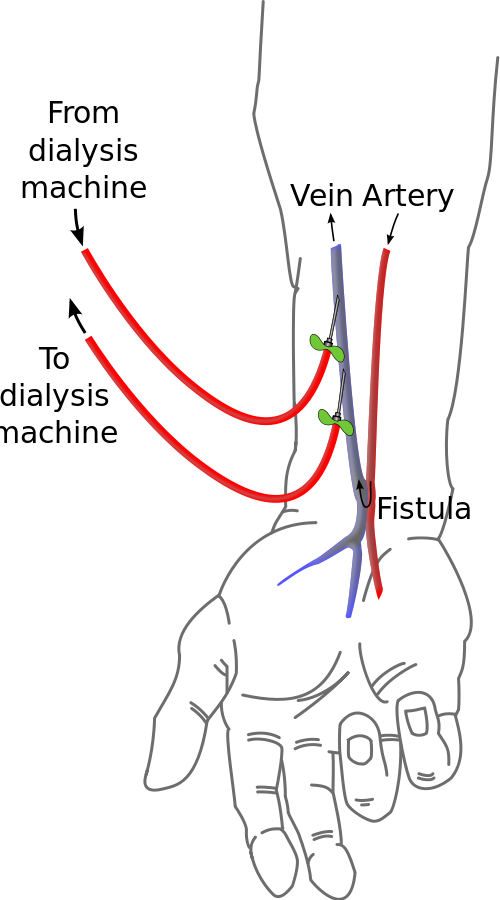Difference Between Fistula and Hemorrhoids
A fistula is an abnormal connection or tunnel that forms between two parts of the body. Hemorrhoids are swollen veins that form in the anal canal.

What is Fistula?
Definition:
A fistula is an abnormal connection or tunnel that has formed between two parts of the body that often leads to problems such as infection. A fistula can develop between the rectum and vagina or between a part of the anus and the skin.
Symptoms and prevention:
Symptoms of a fistula will vary depending on where exactly it is found. In the case of an anorectal fistula, an opening occurs on the skin from the anus, and there is often an unpleasant odorous discharge and pain present. A rectovaginal fistula is when there is a connection between the rectum and vagina, in which case there will be symptoms such as leaking of bowel contents through the vaginal canal, as well as frequent vaginal infections that are also foul smelling. It is difficult to prevent fistulas from developing but controlling and treating inflammatory bowel problems may be helpful.
Diagnosis and causes:
Diagnosis of fistulas involves a physical examination and also techniques such as sigmoidoscopy or CT scan. Various contrast tests can also be done to determine if substances are leaking through fistulas into the vagina or skin. Fistulas can be caused by traumatic events such as surgeries or even childbirth. Serious infections and inflammation of the bowels such as Crohn’s disease can also cause a fistula to form.
Risk factors and treatment:
People who have certain inflammatory conditions of the bowels do have an increased risk of developing a fistula. The fistula can be fixed through surgery but sometimes it does reoccur, particularly if it is classified as a complex fistula with associated abscess development. The surgery that is sometimes done is known as a fistulotomy and this involves opening up the fistula, removing infected material and then carefully closing the tunnel.

What is Hemorrhoids?
Definition:
Hemorrhoids is the condition in which blood vessels that are located in the anal canal swell in size. These vessels are veins which dilate and they can occur inside or even outside of the anal canal.
Symptoms and prevention:
There may be no symptoms but sometimes a person can have pain and there may be bleeding that occurs upon defecation in some cases. Prevention of hemorrhoids involves avoiding straining during constipation. Constipation should be treated using stool softeners to help reduce the need for straining during defecation.
Diagnosis and causes:
A physical exam in which the anus is examined can determine if you have hemorrhoids. An anoscopy, sigmoidoscopy, or colonoscopy can also show the presence of internal hemorrhoids. Hemorrhoids can be caused by straining due to constipation, or from lifting heavy weights. Occasionally pregnancy can also lead women to develop hemorrhoids.
Risk factors and treatment:
A risk factor for developing hemorrhoids is chronic constipation and childbirth. The symptoms can be treated by taking warm sitz baths and also by controlling constipation through taking stool softener medications such as docusate. Hemorrhoids that are thrombosed may need to be surgically removed. Various anesthetic creams can also be used to help with the pain of hemorrhoids.
Difference between Fistula and Hemorrhoids?
Definition
A fistula is an unusual connection or tunnel that develops between two parts of the body such as between the anus and the skin and the rectum and vagina. Hemorrhoids are swollen, dilated veins that occur in the anal canal.
Symptoms
Symptoms of a fistula are pain and an unpleasant and foul-smelling discharge. Symptoms of hemorrhoids include pain and sometimes bleeding when defecating.
Causes
Fistulas can be caused by some type of trauma, such as difficult childbirth; and they can be caused by certain inflammatory bowel conditions such as severe Crohn’s disease. Hemorrhoids may be caused by childbirth and are often the result of straining during defecation because of severe constipation.
Risk factors
Having an inflammatory bowel disease such as Crohn’s disease is a risk factor for fistula development as are certain surgeries, or a difficult childbirth. Suffering from chronic and severe constipation is the main risk factor for the development of hemorrhoids.
Treatment
Fistulas are generally best treated by a fistulotomy surgery. Hemorrhoids may need to be treated by having a hemorrhoidectomy surgery, but in mild cases can be treated by anesthetic creams or warm sitz baths.
Prevention
Fistulas can be prevented by better treatment of inflammatory bowel problems. Hemorrhoids can be prevented by using stool softeners to prevent constipation and straining during defecation.
Table comparing Fistula and Hemorrhoids

Summary of Fistula Vs. Hemorrhoids
- A fistula is an unusual connection or tunnel formed that forms between two regions of the body.
- Hemorrhoids are swollen blood vessels found in and around the anal region.
- Both a fistula and hemorrhoids may require surgical intervention in severe cases.
- A fistula can lead to many infections while hemorrhoids can become thrombosed which then means that surgery is needed.
- Inflammatory conditions of the bowel increase the risk of developing an anorectal fistula.
- A difficult childbirth can cause a fistula to develop or even hemorrhoids in some cases.
- Mostly a fistula and hemorrhoids are not too problematic but in severe cases, they may need to be surgically treated.
- Difference Between Rumination and Regurgitation - June 13, 2024
- Difference Between Pyelectasis and Hydronephrosis - June 4, 2024
- Difference Between Cellulitis and Erysipelas - June 1, 2024
Search DifferenceBetween.net :
Leave a Response
References :
[0]Ansari, Parswa . “Anorectal fistula”. Merckmanuals. Merck & Co., 2018, https://www.msdmanuals.com/professional/gastrointestinal-disorders/anorectal-disorders/anorectal-fistula
[1]Ansari, Parswa . “Hemorrhoids”. Merckmanuals. Merck & Co., 2018, https://www.msdmanuals.com/professional/gastrointestinal-disorders/anorectal-disorders/hemorrhoids
[2]Jordán, J., et al. "Risk factors for recurrence and incontinence after anal fistula surgery." Colorectal Disease 12.3 (2010): 254-260.
[3]Image credit: https://upload.wikimedia.org/wikipedia/commons/thumb/c/c0/Radiocephalic_fistula.svg/500px-Radiocephalic_fistula.svg.pnghttps://upload.wikimedia.org/wikipedia/commons/thumb/c/c0/Radiocephalic_fistula.svg/500px-Radiocephalic_fistula.svg.png
[4]Image credit: https://commons.wikimedia.org/wiki/File:Hemorrhoids.png
